Most audiophiles will see a $7000 headphone amplifier and say to themselves, “Man, that’s one expensive amp. It better make coffee, too!” Well, my music loving friends…this full-bodied, musically rich “HEADTRIP” amplifier, not only serves up a super fine cup of carefully concocted, caffeinated rush of musical goodness. But it also guarantees that when you hear this amp for the first time, it will send a deeply satisfying rush of musical “espresso” coursing through your heart and into your soul, rockin’ every fiber of your musical being.
Decaf lovers need not apply here. Just one listen and it will have Antonio Banderas crooning, “Ah yesss!” Yes, it is that good.
Man, I do love the smell of new electronics in the morning .
Do I sound excited? Well, excited I am.
Jeff Wells has been passionate for most of his adult lifetime in the pursuit of producing the best musical presentation that audio components can provide. He envisioned exactly what his goal was when he started out creating this amp. In his own words: “To create the best sounding home audio amp in the world”. An amp that would produce sound and satiate listeners with a delivery that would come as close as possible to the original recording, and make it available to other music lovers to have and to hold.
He had already been designing and manufacturing his coveted 2 channel speaker amplifiers, named the Innamorata and Innamorata Signature (Italian for: To cause to fall in love, a woman with whom someone is in love, a mistress [from Jeff’s website]). Espresso with a twist! That’s amoré…
A good industry friend of his, Joe Skubinski of JPS Labs (Abyss Headphones) came to Jeff and requisitioned him to make him a headphone amplifier that would mirror the quality and sonic characteristics of the Wells’ speaker amps. This is how and when the Headtrip was born. The Headtrip uses many of the same components and features of his Innamorata design, more suitable to work in harmony with headphones.
He has also recently created and has begun selling his lower priced version called the Enigma, which has a price of $3699 and saves some serious coin by not using some of the higher priced, uber-expensive components that he uses to top out the Headtrip. We will get to those components in a bit.
Jeff told me that his amp is based on a published 40-year-old steadfast amp design that he spent countless hours improving on, by swapping components and altering specifications to create a sound that doesn’t only hinge on mathematical formulas and engineering equations, but rather, his own ears. The Headtrip went through multiple revisions and tweaks before Jeff says he finally heard what he knew was going to be the exact Wells house sound that he was looking for. He knew definitively when he finally had the finished product that was ready for his prime time objectives.
Did Jeff obtain his goal of Audio Nirvana? I personally think he did!
What makes one higher-end amplifier stand out levels above the rest of the pack, you might ask? I venture to say that there are two important criteria’s. Build quality and sound presentation.
Build Quality and Design:
The way to achieve a high quality build is to use well-placed alloys for the chassis, and the highest quality hardware that makes practical sense in the designer’s desired price point. The chassis and heatsinks are milled from aluminum and the faceplate is made from Cast Acrylic, which Jeff says is stronger than the usual acrylic plastic that one can find on typical audio amps. Grounding and supplied power isolation plays an important role. Jeff’s chassis is built like the glorious amps of yesteryear that were made to stand the test of time. When you first remove it from it’s carefully crafted shipping boxes and place it in your system, it screams out quality and craftsmanship! Vertical heat sink fins run along the left and right sides of the amp body to take on the responsibility of keeping the unit cool, and the amp weighs a respectable 20lbs. I found it surprising that a headphone amplifier that outputs 25 watts/channel into 32Ω (50 watts into 8Ω and 1.8 watts into 600 ohms) emits so little heat. One can only attribute this to an intelligent, efficient design.
The HEADTRIP features two blue LEDs indicating power to the left and right channels and has two Neutrik combo ¼”/XLR headphone outputs which allow you to run two single ended cans at the same time without breaking a sweat, or choose one dual 3-pin XLR terminated favorite to feed the sumptuous analog waveforms into the space that is between our sunglass holders. Also included are front mounted left and right channel polarity flip switches. Wells Audio believes that 30% of all digital recordings are incorrectly recorded out of phase (think Miles Davis’ Kind of Blue) and this offers the user the opportunity to right the wrongs.
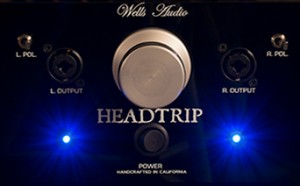
The volume control is of the stepped attenuator type, which utilizes Takman resistors for a constant level linear volume control. This helps you find the exact in-between volume that you want, and not go from soft to very loud in one click as standard wiper volume pots can do as you get higher up in the volume range.
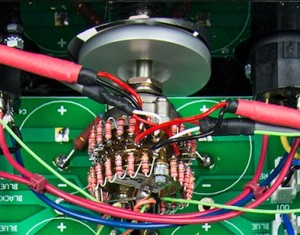
On the backside your eye can spy a Furutech gold plated IEC for power connection and two WBT Nextgen RCA inputs ($50/pair), along with a pair of XLR inputs for connecting your source. If you plug in the XLR and SE inputs at the same time, I found that the WTB RCA single ended inputs become disabled.
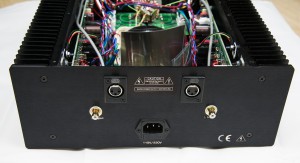
Sound presentation:
When an engineer or as Jeff calls himself, “a designer” has a desire to make an upscale product that will produce musical sounds that he hopes can be called “The best home audio amp in the world”, there are a couple of critical items they need to use to achieve their goals. First, the highest quality components that will make a positive, noticeable difference in the design, and secondly, something that most of us got from our moms. A pair of ears. When I interviewed Jeff Wells, he confessed to me that he uses his (ears, that is), every step of the way throughout his manufacturing process to voice his sound. He believes in the “KISS” (Keep It Simple Stupid) approach.
He doesn’t believe complicated mathematical equations are the answer to proper amplification. Instead what the amplifier actually sounds like is more the answer he is looking for. Each time Mr. Wells swaps in and out each capacitor, each resistor… every time he applies heat and experiments with different varieties of solder, he carefully listens to it. Slowly sculpting his creation until it is what it should be. Even when his masterpiece has passed his approval he then burns in each unit he sends out for review for 450 hours, listening in intervals as it goes through the maturing process, until finally it sounds precisely as he wants it to sound. “Serve no wine before it’s time”. Then and only then is he willing to put on the Cast Acrylic faceplate that bears his namesake. To put that in perspective, that’s 18 and ¾ days of obsessing over perfect sound.
Jeff says that he is at the point in his life where money is not the most important thing he is looking for, in making and selling his equipment. He wishes his products to be good enough, that when he moves on to the great beyond, his children and grandchildren will hear others talking about the “legacy” that Jeff Wells left behind. That is his motivator. That’s what inspires Jeff each morning and how he approaches his projects and builds.
Getting back to those pricey Components:
Revisiting the question of why this amp sounds so darn good, and why it costs $7000…the proof is in the pudding. We usually find out that “garbage in = garbage out”. In this case, greatness in = more than greatness out. In order to have superior sound, like a house, it must be built on solid foundation. In the case of amplifying sound, the goal is to start with a noise floor that is as close to dark zero as possible. For those of us that don’t live in the mountains of Utopia, the electricity that is piped in to our dwellings usually has a lot of impurities and noisy “crap” flowing through it.
This is why it is important to use quality cabling that keeps out the EMI and RFI that is desperately trying to get into our music listening sessions and muck things up for us. Two things that usually make up a good cable: using a wire with as little impurities possible to stand in the way of the signal path, and some good insulation to stop the “stuff” on the outside from getting into the “stuff” on the inside.
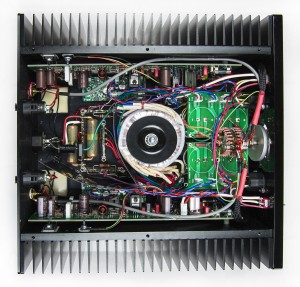
Bybee Technologies is well known in the industry for making quality filters and rails for smoothing out and cleaning up the signal path that runs through higher quality components. They are good, and they are good and expensive! They also run up the cost of the products that use them, but isn’t something worth extra if it makes a huge difference in something that is important to you? In this case, it brings the ability to make really good sound, up a couple of very large notches.
The Wells HEADTRIP uses a pair of Bybee AC Purifiers for AC line noise filtering that cost $720/pair. It also utilizes a pair of Bybee Music Rails that set the consumer back $350/pair. The Music Rails claim to filter the DC noise by up to -45db.The Rike PIO (paper-in-oil) input coupling capacitors are $75 and they get lonely if they don’t come in pairs, so a pair it is. PIO capacitors take a long time settle in. This is one reason why “burn-in” is so vital before evaluating an audio product that contains them, and there is a noticeable improvement in sound over time.
What I am hearing from all of this goodness is crystal clean details, slamming bass, a quiet background, and incredibly fast recovery between cymbal transients. More so than I’ve heard in any other combinations of amps and my noteworthy collection of headphones. One memorable experience that comes to mind, was when I was watching and listening to “Toys” from World of Rhythm (Herbie Hancock, Ron Carter) with Billy Cobham hitting the top and then the bottom of his crash cymbal so quickly, you have to run the DVD-Video DTS in slow motion to really see it happen. It usually sounds like a minor mess on most systems. Even hummingbirds would be amazed at the speed and pace this amp kept up. The recovery was remarkably quick on the HEADTRIP.
“When is he going to get to how it sounds”, you might ask (in a whiny voice)?
How it sounds:
By now, you can tell that either Jeff Wells is one of my favorite relatives, or else I really, really love this amp.
I really, really love this amp.
In order to make sure that I heard the best sound possible from this amplifier, I wanted to use similar cabling from the beginning of the chain, to the end. Alex Sventitski of WyWires rose to my challenge and sent me a plethora of his company’s Platinum cable line to demo, along with their Red Series headphone cable. I originally started my review using my tried and trustworthy Cardas Golden and Neutral Reference cables (with the exception of the digital interfaces, which varied). I thought that the sound that I was hearing couldn’t get any better, until I replaced everything with the WyWires offerings, and the sound improvement was quite noticeable. Where does it all end? It never does. That’s the fun part of the hobby!
An industry associate of mine, and fellow Head-Fier, Fred Ainsley (nicknamed – Gopher) of Destination Sound Corp. who is the exclusive US and Canada distributor of LampizatOr, NA graciously offered to lend me an available DAC Level 4 version to use with this amp. I used my Esoteric DV-50 out as my source through S/PDIF 75Ω coaxial digital into the Lampi DAC. Second source that I used was my MacBook Pro feeding 0’s and 1’s, through a beautifully constructed WyWires Digital USB interface, exporting high-resolution 24bit/96 and 192kHz music files into the LampizatOr DAC, which ultimately fed into the Wells amp.
I have always thought of every recording to be like a densely complicated, uniquely unidentifiable sealed bundle of sound…something akin to that of an onion. No two onions are alike. Each one having a inimitably different personality of tightly knit leaves running down the corridors of its own one-of-a-kind orb, each with it’s own flavor, living harmoniously in a shared community, waiting for someone or something to come and peel it open to set it free. Free to spread its wings and express itself out into the world…to unleash its flavors.
The recording, good or bad, is a closely packed package of analog waveforms that require the aid of a great amplifier to unpack it properly, in order to present it to the listener. Audiophiles are always on the constant pilgrimage to find the greatest recordings and find the proper tools to utilize them to the maximum. The HEADTRIP takes this recording, gingerly spreads open it’s hidden layers, one by one, giving them the space and air they need to tell their own story. All the while drawing out all of the flavor that the original recording documented in the studio. Think of the precious music file as the onion, all tight and compressed in it’s own shallow skin, and the Wells amp as the Master Chef, setting the onion down on the table in all it’s glory. Exposing its strengths and weaknesses, portraying its depth, scope and individuality in every note.
I started out my musical journey with the HEADTRIP listening to Patricia Barber’s “Whiteworld” on her album, “Fortnight in France”. For any Jazz lovers that crave a top notch live recording, with superior professional musicians, complicated female vocals, syncopated drum riffs and blazingly hot piano, bass, and guitar licks, this album is for you. “Whiteworld” is a feverishly fast-paced song, which confuses a great deal of equipment that I have used. Lower end components, and even some higher end ones, trip over the delicacies of this song like the saloon drunkard leaving after last call. This amp dissects the presentation with ease and the grace and professionalism that places it on the top of the pack from its competitors.
I wanted to hear what it could do with some raw, riveting, raunchy 60’s rock that pulls no punches. Music like what you would hear live on the stage. I listened to a binaural recording of Creedence Clearwater Revival’s “Suzy Q”. Simply put, a great rock band playing an awesome rock song. No punches pulled, no tricky mastering techniques. Just me listening to the song, eyes closed, picturing myself sitting 6 feet away from the stage. A good way to describe how well the Wells amplifies this song, is to remind the reader of when they attended their very first live rock performance, and remembering hearing how the bass drum “really” sounds like…LIVE. That’s what the Suzie Q bass drum sounds like on the HEADTRIP. “Thump…badda, badda thump…!”
To me, some of the best-recorded music comes from the era where Jazz trios, quartets and quintets ruled in the 1960’s. The use of 3-track recording was popular in some of the better recording studios (think Sonny Rollins, “Way Out West”). Piano or saxophone in the left channel and drums and bass living in the right. I like to use my HDTracks 1962 version of Bill Evans “Empathy”. Track one is “The Washington Twist” on Verve records and I like to fully utilize it to compare the full compliment of Shelly Manne’s cymbal ensemble. To put in perspective how magical this amp sounds, when hearing the song, just picture in your mind what it sounded like when you snuck down in your brother’s friend’s basement when they took a “lemonade” break, and you picked up a drumstick for the first time and gently tapped it on a real, live cymbal. That’s what “The Washington Twist’s” cymbals sound like on the HEADTRIP. “Keeessshhhhh….”
What good is a TOTL (top of the line) headphone amplifier if it can’t accurately produce busy Classical performances? I was delighted to listen to Kim André Arnesen’s – “Magnificat”, which is said to be about the Virgin Mother’s song of praise when she knew she was going to carry a very special child. It is a large-scale works for chorus and orchestra. What better “tune” can one find to test the limits of this amp’s potentials? The string instruments sang out with a clarity that causes calmness and satiation to enter the listener’s soul. I can’t say that I was as inspired as the Virgin Mother in this song, but I was pretty “darn-tootin” pleased. When hearing this song, just picture the first time as a kid that someone forced you to sit and listen to this slow paced genre of classical music and how easily it made you fall into deep, peaceful slumber on the couch. That’s what orchestral music sounds like on the HEADTRIP. ZZzzzzzzzz…..
In conclusion:
The Wells HEADTRIP headphone amplifier stays true to the recording. As true as any amp I’ve ever heard. It provides fast recovery between the complicated passages, and produces a clean, detailed, open-spaced recognizable soundstage. It has a unique ability to take a complex congested piece, and give everything it’s own zip code so that each instrument, each note, can be identified and enjoyed. It gives the saloon drunk at closing time, fresh oxygen, sobriety, and a new lease on life.
Above all else, it is extremely enjoyable to listen to for hours on end without overloading my senses and creating any feelings of fatigue.
I would like to see two things changed if I were lucky enough to own one of these beauties. The ability to control the intensity of the Blue LED’s on the front panel. During the day they look great, but at night, during my intimate listening sessions, I find the blue light is too bright. The second thing is minor, but the two O-rings that provide grip on the volume knob can start to walk off if I grip them too tightly. Either a smaller diameter or a light adhesive might alleviate that.
Anyone who has the ability to own this amp would certainly be the king of his or her audio community. A consumer would be hard pressed to find something equal to or better than this beautiful piece of audio perfection.
Equipment Used:
Sources:
-Esoteric DV-50 Universal Player
-Apple Macbook Pro 15” Retina
-Theta Data Basic CD Transport
Digital Conversion:
-Lampizat0r Level 4 DAC
Headphones:
-HIFIMAN HE-1000 w/WyWire Red Series
-Beyer Dynamic T1
-Audio Technica ATH-AD2000
-HIFIMAN HE-6 w/WyWires Red Series
Cabling:
-WyWires exclusive throughout
Specifications (from manufacturer):
Phone impedance: 4 to 2000 Ohms
Power output: 50w/channel at 8 ohms, 25W/channel at 32 Ohms
1.8W/channel at 600ohms
Distortion: <0.006% at 1Khz at .1W to 100W at 4 Ohms
Frequency Response: +/-0.25db from 10Hz to 50Khz
Signal to Noise ratio: -103db at full power
Input Impedance: 50K Ohms
Input Sensitivity: 85 mv
Gain: 30db
Voltage: 110v, 120v, 220v, 230v, 240v at 50/60 Hz
Inputs: 1 pair WBT Nextgen RCAs or 1 pair XLRs
Outputs: 1 pair Neutrik combo ¼ inch/XLR outputs
Dimensions: 12.25” x 14” x 5” 16” x 14” x 8” shipped
Weight: 20 lbs.
M.S.R.P – $7000.00














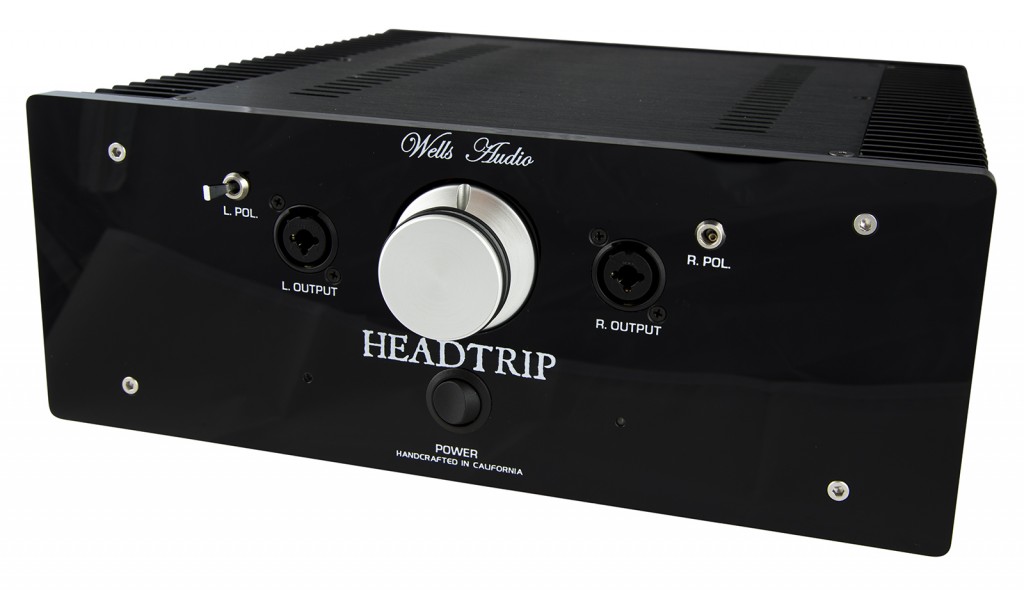
Reply
Reply
Reply
Reply
Reply
Want to join discussion?
Feel free to contribute!